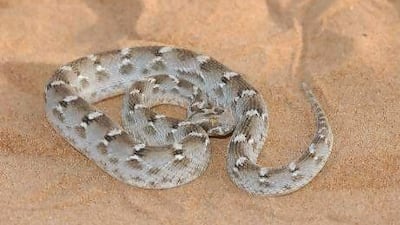DUBAI // Armed with a powerful venom and lightning reflexes, the saw-scaled viper is the country's deadliest snake.
And as cities spread, the reptile, which once preferred sandy desert regions, has now been attracted to residential areas by an abundance of prey and water.
"The population and breeding patterns of the viper used to be pretty low because they would normally only be found in sandy desert areas," said Johannes Els, head of reptiles at the Breeding Centre for Endangered Arabian Wildlife in Sharjah.
"This species has benefited significantly due to the irrigation of gardens, which become an easy and constant source of water."
Mr Els regularly receives reports of sightings from across the country. "In a month I can easily collect 20 to 40 of these snakes from one Sharjah industrial area alone," he said. "During the summer months, between May to October, they are more active and like to head indoors or in the shade to help regulate their body temperatures.
"Air-conditioned buildings are perfect for them, and we do see a rise in the number of reports in residential buildings."
Fortunately the snake is not aggressive by nature and if disturbed is more likely to slither away quietly than to lash out.
"The saw-scaled viper's first reaction is to move quickly away from potential danger," says Mr Els. "If provoked by trying to catch or kill, it will coil into a horseshoe shape and rub its scales against each other to produce a rasping sound."
If this warning is ignored, the snake is likely to "deliver a series of strikes".
Anyone bitten is advised to follow a strict procedure. "The first thing is not to cut the area that is bitten in an attempt to release the venom," said Dr Mohamed Yousif Hasan Baniyas, a consultant toxicologist at Tawam Hospital in Al Ain. Doing this would only increase the loss of blood.
Instead the patient must be taken to hospital immediately for a bandage to be applied to the bitten area. "The key thing is that the bandage is strapped only lightly and blood circulation isn't restricted. Otherwise it could result in anaphylactic shock and blood not getting to the limb that's been bitten, which in turn could result in it being lost."
The viper's venom slowly prevents the blood from clotting. The human body reacts to the poison with pain and swelling, followed by systemic bleeding within six to 72 hours. If untreated it can cause internal haemorrhaging and eventually organ failure.
"Compared to the Arabian horned viper, the venom of the saw-scaled viper is more toxic," says Mr Els. "We have four medically important venomous snakes in the UAE. Two of the species - the Oman carpet viper and the Persian false horned viper - are restricted to the mountains."
The saw-scaled viper, Echis carinatus sochureki, can grow up to 80cm. Its main prey are rodents, lizards and frogs.
And it can be useful. Not only does it help control the rodent population, proteins found in its venom can be used in medicine, including treatments for heart disorders - and even the common headache. The venom is also used to produce the life-saving antivenin used for treating snake bite victims.
The saw-scaled viper is light to dark brown in colour and has a series of crossbars along the spine, which are inverted with light coloured V-shapes. It has a whitish or pinkish belly.
An ambush predator, the viper is largely nocturnal, though it can sometimes be seen on overcast days.
"When in ambush they will remain motionless for hours until prey comes along, after which they will deliver a quick strike when in range. They will hold on to the prey till it dies after which they will start to eat from the head first."
Typically the females give birth to eight to 23 hatchlings during the winter breeding season.

